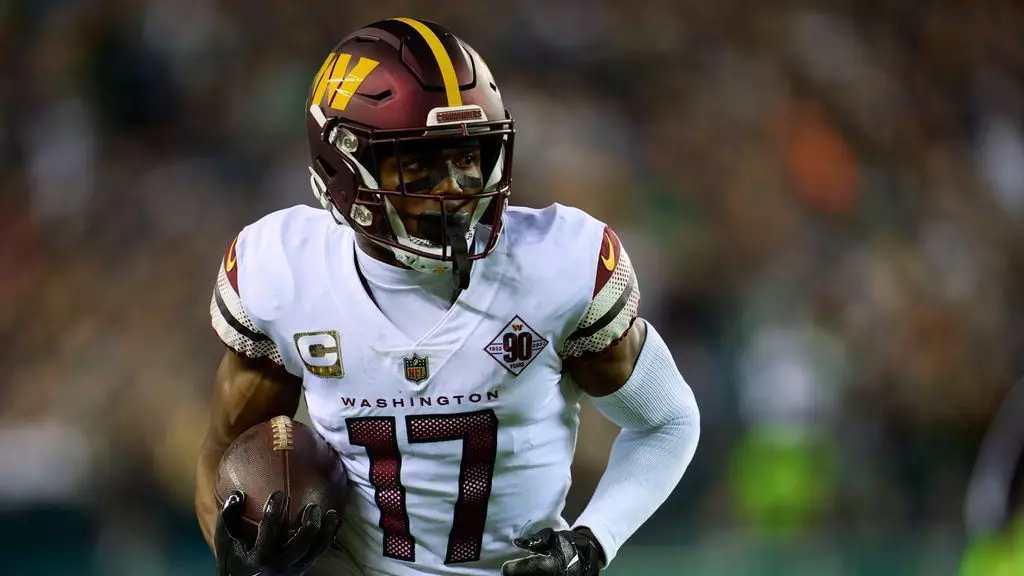In an era where athletes wield unprecedented influence, the subtle fracturelines within NFL organizations are becoming more apparent. The recent saga of Washington Commanders receiver Terry McLaurin exemplifies a growing disconnect between players’ aspirations and the static management structures that govern their careers. While team officials publicly dismiss trade requests as standard business, beneath the surface, they reveal an unsettling complacency that neglects the human element at the heart of the sport. The NFL’s culture of valuing profit and performance over player well-being creates an environment where individual dreams and professional stability often clash, risking long-term damage to both teams and their athletes.
McLaurin’s trade request, seemingly just another transactionline in the league’s relentless machinery, exposes a deeper malaise. His demand for a contract extension, driven by the natural desire for financial security and recognition, collided with a team hesitant to meet market standards. Yet, the official response emphasizes professionalism, downplaying any discord. This disconnect between the emotional reality of players and the sterile language of team management fosters a toxic atmosphere of unspoken dissatisfaction. Teams that dismiss these signals risk losing their best talent not through the open gate of a formal departure but through a series of silent resignations that undermine team cohesion and morale.
The Myth of Business as Usual
The NFL often cloaks these disputes as routine business negotiations, but this narrative glosses over the vulnerability of athletes. When a star like McLaurin, who contributed significantly to his team’s offensive success, publicly requests a move, it reflects frustrations that extend beyond mere dollars. This is a sign that players are increasingly aware of their value and are willing to challenge the accepted narrative that they are commodities to be traded or undervalued. The league’s tendency to frame such issues as normal business operations diminishes the real human stakes involved, trivializing the personal sacrifices athletes make for a game that often pays them a fraction of the revenue they help generate.
More troubling is the tacit acceptance by coaches and management that these conflicts are unavoidable. Dan Quinn’s comments aim to project calm, yet they overlook the underlying dissatisfaction simmering in the locker room. The language of “normal business” subtly absolves teams from addressing the core issues—contract fairness, health concerns, and recognition—leaving athletes to navigate a system that favors ownership’s bottom line over individual rights. This approach breeds resentment and erodes trust, undermining the very foundation of team unity, which should be built on mutual respect and understanding.
The Cost of Infidelity and the Illusion of Loyalty
Beyond the immediate impact, McLaurin’s case reveals an uncomfortable truth: the toxicity of NFL contract negotiations and the widening disparity between player performance and financial reward. McLaurin, a consistent performer, finds himself in a precarious position—approaching 30, with a strong résumé but facing a league that devalues aging receivers. The reluctance of Washington to meet his market value speaks volumes about a system that favors youth and speculative investments over proven talent. Such policies foster a climate of insecurity for veteran players, discouraging loyalty and incentivizing short-term gains over genuine team-building.
This fraying loyalty complicates management’s ability to craft cohesive, motivated teams. Meanwhile, the league’s obsession with dollar figures and age limits feeds a cycle of discontent that will inevitably boil over. As clubs cling to fiscally conservative strategies, they risk alienating their most vital assets—players who, despite their importance, are often incentivized to look elsewhere for better compensation. The risk is a fractured league where trust is a rare commodity and the human costs of such discord are felt far beyond the locker room, affecting fan engagement and the sport’s integrity.
The Future of Player-Organization Relationships
The NFL’s future hinges on whether franchises recognize that a player’s well-being should be intertwined with organizational success. The delicate balance of power is shifting; players are increasingly asserting their rights and demanding respect for their careers beyond the game itself. McLaurin’s situation exemplifies a pivotal crossroads, where teams must decide whether to continue dismissing these disputes as normal or to adapt and foster genuine dialogue.
Ignoring these signals invites chaos, demoralization, and the dilution of brand trust among fans. For the league to thrive in a social climate increasingly committed to fairness and athlete rights, it must confront its own shortfalls. That begins with recognizing players not merely as investment assets but as critical stakeholders who drive the league’s ecosystem. The time has come for NFL management to reform their approach—embracing transparency, equitable contracts, and a genuine commitment to the athletes’ long-term careers. Anything less risks turning the sport into a relic of exploitation rather than a celebration of talent and perseverance.


Leave a Reply